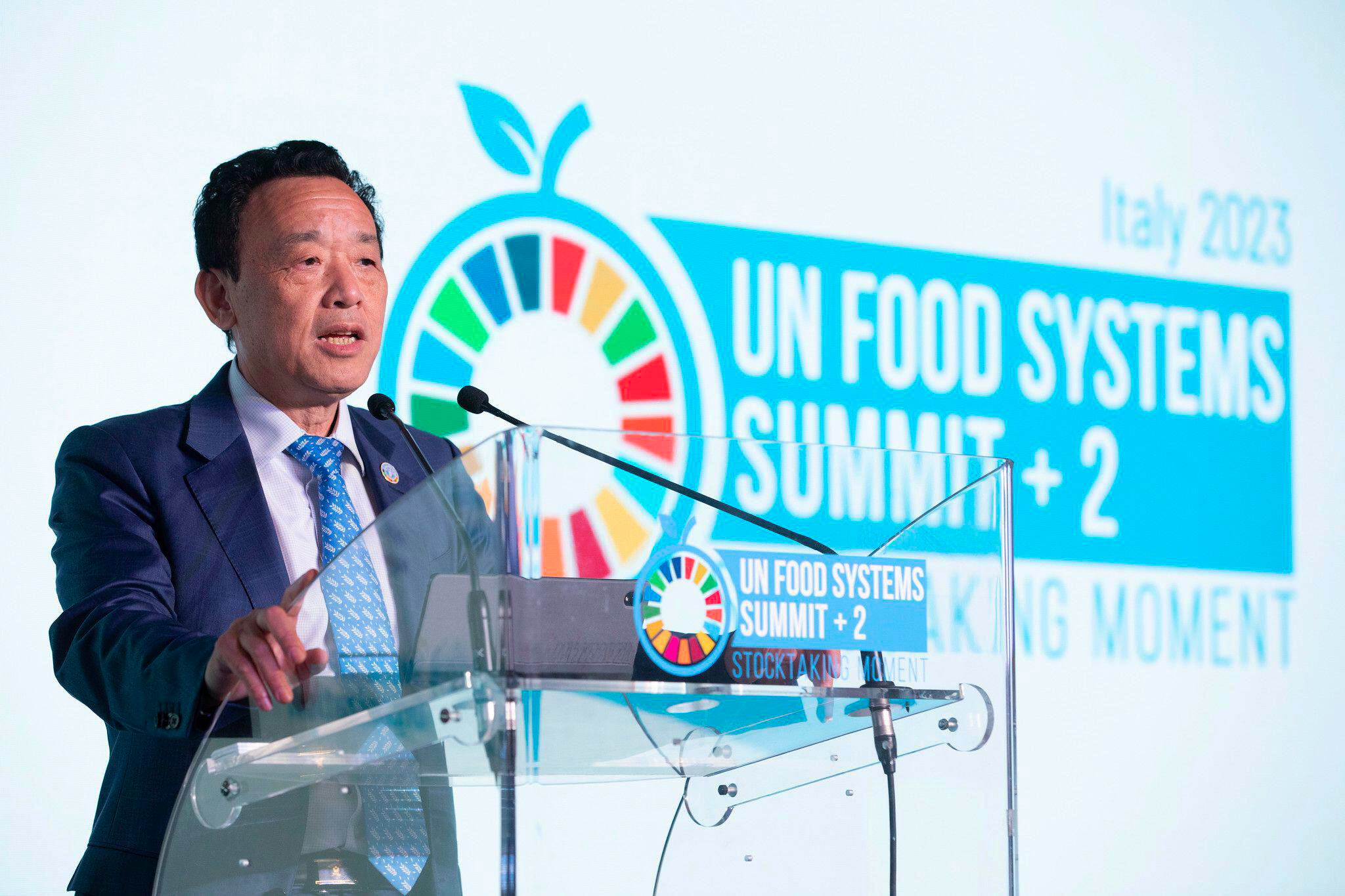Flagship UN Food Systems Summit Accused of ‘Selling the Corporate and Industrial Project’
Flagship UN Food Systems Summit Accused of 'Selling the ... DeSmog


Sustainable Development Goals and the UN Food Systems Summit

Indigenous peoples, smallholder farmers, and academics have expressed concerns that the UN Food Systems Summit (“FSS+2”) held last week has further consolidated corporate control over the global food system.
The FSS+2 took place as countries are striving to reduce agriculture’s climate impact in preparation for the COP28 summit in December. Agriculture is responsible for 34 percent of the world’s anthropogenic greenhouse gas emissions, according to the UN’s Food and Agriculture Organization.
However, the recent Food Systems Summit highlighted the divergence between agribusiness giants and smaller food producers regarding the transformation of the food system to achieve emission reductions and address hunger, malnutrition, and biodiversity loss.
Companies such as Nestle, Unilever, Bayer, and FMC, a fertilizer giant, have used both summits to promote “solutions” that they are uniquely positioned to provide, including “precision agriculture” and increased pesticide and fertilizer use.
According to Saúl Vicente from the International Indian Treaty Council, the Food Systems Summit was merely a “rebranding” exercise for companies seeking to maintain environmentally harmful industrial agriculture practices. Vicente stated that the summit overlooked indigenous peoples’ rights and the structural causes of the crises.
Prioritizing Stakeholders
Prior to the UN meeting, members of the People’s Autonomous Response to the UN Food Systems Summit, a group representing indigenous and smallholder food producers advising the UN on hunger and food security, held a press conference to address the growing influence of industrial agribusiness in global food system governance.
The People’s Autonomous Response claims that the UN failed to address concerns raised during the first summit in 2021, which suggested that the process had been co-opted by corporate interests. The group argues that the previous event marginalized countries from the Global South, allowing big corporations to design a system that primarily benefits their own interests.
Industrial agriculture contributes to deforestation, water pollution, biodiversity loss, and significant methane emissions. It heavily relies on fossil fuels for vehicles, pesticides, fertilizers, and food transportation. Additionally, it often subjects workers to low wages, insecure employment, and hazardous working conditions.
Critics argue that the industry is attempting to “solve” the problems it has caused. Jennifer Clapp, a professor of global food security and sustainability at the University of Waterloo, stated that this year’s Food Summit failed to address the root causes of the industry’s issues. Clapp emphasized the importance of understanding the problem before determining the solution.
While agribusiness giants favor intensifying existing agricultural practices and scaling up technology use, many smallholder farmers and indigenous groups advocate for a shift towards more environmentally friendly agroecological approaches. They are concerned that increasing the power of large companies will exacerbate existing failures of the global food system.
For instance, under the guise of “precision agriculture,” farmers are being encouraged to rely more on data collected through the use of drones, robots, sensors, and other technologies. However, this data is typically owned by large private companies, making farmers dependent on their technologies.
The emphasis on “digital” and “precision” farming models in the Food Summit’s official program reflects a prioritization of stakeholders over rights holders. This is problematic given the high levels of hunger and undernutrition and the significant power imbalances in the system.
The UN Food Systems Summit did not provide a comment on the record.
SDGs, Targets, and Indicators Analysis
1. Which SDGs are addressed or connected to the issues highlighted in the article?
- SDG 2: Zero Hunger
- SDG 13: Climate Action
- SDG 15: Life on Land
The article discusses the issues related to the global food system, including hunger, malnutrition, biodiversity loss, and the climate impact of agriculture. These issues are directly connected to SDG 2 (Zero Hunger), SDG 13 (Climate Action), and SDG 15 (Life on Land).
2. What specific targets under those SDGs can be identified based on the article’s content?
- SDG 2.3: By 2030, double the agricultural productivity and incomes of small-scale food producers, in particular women, indigenous peoples, family farmers, pastoralists, and fishers, including through secure and equal access to land, other productive resources and inputs, knowledge, financial services, markets, and opportunities for value addition and non-farm employment.
- SDG 13.2: Integrate climate change measures into national policies, strategies, and planning.
- SDG 15.2: By 2020, promote the implementation of sustainable management of all types of forests, halt deforestation, restore degraded forests, and substantially increase afforestation and reforestation globally.
Based on the article’s content, the specific targets that can be identified are SDG 2.3 (doubling agricultural productivity and incomes of small-scale food producers), SDG 13.2 (integrating climate change measures into national policies), and SDG 15.2 (promoting sustainable forest management and halting deforestation).
3. Are there any indicators mentioned or implied in the article that can be used to measure progress towards the identified targets?
- Indicator for SDG 2.3: Agricultural productivity and incomes of small-scale food producers
- Indicator for SDG 13.2: Integration of climate change measures into national policies
- Indicator for SDG 15.2: Forest area and deforestation rate
The article does not explicitly mention specific indicators, but the progress towards the identified targets can be measured using indicators such as agricultural productivity and incomes of small-scale food producers (for SDG 2.3), integration of climate change measures into national policies (for SDG 13.2), and forest area and deforestation rate (for SDG 15.2).
SDGs, Targets, and Indicators Table
| SDGs | Targets | Indicators |
|---|---|---|
| SDG 2: Zero Hunger | 2.3: By 2030, double the agricultural productivity and incomes of small-scale food producers, in particular women, indigenous peoples, family farmers, pastoralists, and fishers, including through secure and equal access to land, other productive resources and inputs, knowledge, financial services, markets, and opportunities for value addition and non-farm employment. | Agricultural productivity and incomes of small-scale food producers |
| SDG 13: Climate Action | 13.2: Integrate climate change measures into national policies, strategies, and planning. | Integration of climate change measures into national policies |
| SDG 15: Life on Land | 15.2: By 2020, promote the implementation of sustainable management of all types of forests, halt deforestation, restore degraded forests, and substantially increase afforestation and reforestation globally. | Forest area and deforestation rate |
Behold! This splendid article springs forth from the wellspring of knowledge, shaped by a wondrous proprietary AI technology that delved into a vast ocean of data, illuminating the path towards the Sustainable Development Goals. Remember that all rights are reserved by SDG Investors LLC, empowering us to champion progress together.
Source: desmog.com

Join us, as fellow seekers of change, on a transformative journey at https://sdgtalks.ai/welcome, where you can become a member and actively contribute to shaping a brighter future.







